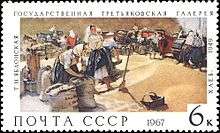Tetyana Yablonska
Tetyana Yablonska (Ukrainian: Яблонська Тетяна Нилівна) (24 February 1917 – 17 June 2005)[1] was a Ukrainian painter. Her early vital pictures are devoted to work and a life of Ukrainian people ("Bread", 1949). She has passed to generalizing images of the nature, differing a subtlety of plastic and color rhythms ("Anonymous heights", 1969; "Flax", 1977).
Tetyana Yablonska | |
|---|---|
| Born | 24 February 1917 |
| Died | 17 June 2005 (aged 88) |
| Nationality | Ukraine |

Yablonska was born in Smolensk, Russian Empire. She studied at the Kiev State Institute of Art (1941), the studio of Fedir Krychevsky. She worked very productively until the very end of her life, reportedly painting her last pastel etude on the very day of her death.
She was elected as a Member of parliament of the Ukrainian Soviet Socialistic Republic (Ukrainian Verkhovna Rada, English Supreme Council) in 1951–58, became a member of the Ukrainian Artists' Union in 1944, a member of the board of the USSR Artists' Union in 1963, and a member of the Academy of Art of the USSR in 1975.
Yablonska was awarded the honorary title "Peoples' Artists of the USSR" in 1982, "Artist of Year" (UNESCO) in 1997, "Woman of Year" (International Biography Centre, Cambridge) in 2000. She was the winner of the USSR State Prize (Stalin prize: 1949, 1951 and State Prize: 1979), and winner of the Shevchenko state prize of Ukraine (1998).
She also received the Order of the Red Banner of Labour (1951), the Order of Friendship of Peoples (1977), order Award for merits (1997) and the highest state award of Ukraine – title Hero of Ukraine (2003).
She died in Kiev on June 17, 2005.
Her students include Mikhail Turovsky.
Selected works
- 1945 – Self-portrait
- 1945 – Enemy is coming
- 1947 – Before start
- 1945 – Khreschatyk' rebuilding
- 1947 – Evening on the Dnieper River
- 1949 – In the square
- 1949 – Вread
- 1950 – Spring
- 1953 – They have caught a cold
- 1954 – In a window spring
- 1954 – Upon the Dnieper River
- 1954 – Morning
- 1958 – The twins
- 1960 – Celebratory evening
- 1961 – In old city Ashtarack. Armenia
- 1962 – Together with the father
- 1964 – Young mother
- 1964 – New windows
- 1964 – Wedding
- 1966 – The life
- 1967 – Paper flowers
- 1967 – Summer
- 1968 – Cradle
- 1969 – Youth
- 1969 – Anonymous heights
- 1971 – The life proceeds
- 1971 – Widows
- 1973 – Evening. Old Florence
- 1975 – Quiet
- 1976 – Winter in old Kiev
- 1977 – Venice. The big channel.
- 1977 – Flax
- 1977 – Gondolas.
- 1979 – In the winter on a farm
- 1979 – Evening on a meadow
- 1981 – June
- 1982 – Gayane is waiting
- 1982 – A portrait of the artist. Volobuev
- 1987 – Autumn shadows
- 1988 – Pearl morning
- 1988 – A shady garden
- 1989 – Green window
- 1989 – An autumn portrait. Gayane' daughter
- 1992 – Under lindens
- 1995 – Light air
- 1998 – In light of autumn. Daughter' portrait
- 1993–98 – Sednyov' landscapes
- 1991–92 – a series "Oberegi" (amulets)
- 1993–96 – a series "Windows"
- 1998–99 – a series "Memoirs"
References
- Tetyana Yablonska. Danusha Fine Arts, 2013. Retrieved 6 May 2013. Archived here.
External links
| Wikimedia Commons has media related to Tetyana Yablonska. |
- Online Gallery of the later works by Yablonska (in Russian)
- Yablonska's site OpenUA.Net (in Ukrainian)
- Tetyana Yablonska: About Herself, Zerkalo Nedeli, #24(552), June 25, 2005. (in Ukrainian, in Russian)
- Interview with her daughter Gayane Akopyan, Komsomolskaya Pravda (in Russian)
- Memoirs of Yablonska, Komsomolskaya Pravda (in Russian)
- L.Vladich.T.N.Yablonska. Kyiv, 1958
- A set of postcards by Tetyana Yablonska